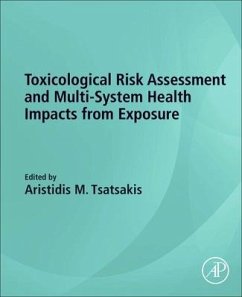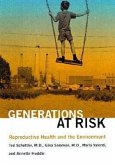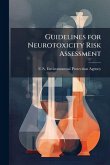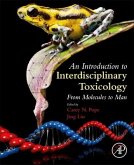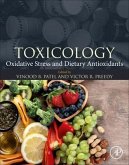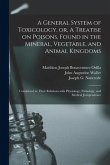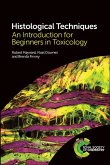Toxicological Risk Assessment and Multi-System Health Impacts from Exposure
Herausgeber: Tsatsakis, Aristidis M
Toxicological Risk Assessment and Multi-System Health Impacts from Exposure
Herausgeber: Tsatsakis, Aristidis M
- Broschiertes Buch
- Merkliste
- Auf die Merkliste
- Bewerten Bewerten
- Teilen
- Produkt teilen
- Produkterinnerung
- Produkterinnerung
Toxicological Risk Assessment and Multisystem Health Impacts From Exposure highlights the emerging problems of human and environmental health attributable to cumulative and multiple sources of long-term exposure to environmental toxicants. The book describes the cellular, biological, immunological, endocrinologic, genetic, and epigenetic effects of long-term exposure. It examines how the combined exposure to nanomaterials, metals, pharmaceuticals, multifrequency radiation, dietary mycotoxins, and pesticides accelerates ecotoxicity in humans, animals, plants, and the larger environment. The…mehr
Andere Kunden interessierten sich auch für
![Generations at Risk: Reproductive Health and the Environment Generations at Risk: Reproductive Health and the Environment]() Ted SchettlerGenerations at Risk: Reproductive Health and the Environment10,99 €
Ted SchettlerGenerations at Risk: Reproductive Health and the Environment10,99 €![Guidelines for Neurotoxicity Risk Assessment Guidelines for Neurotoxicity Risk Assessment]() Guidelines for Neurotoxicity Risk Assessment15,99 €
Guidelines for Neurotoxicity Risk Assessment15,99 €![An Introduction to Interdisciplinary Toxicology An Introduction to Interdisciplinary Toxicology]() An Introduction to Interdisciplinary Toxicology135,99 €
An Introduction to Interdisciplinary Toxicology135,99 €![Toxicology Toxicology]() Toxicology135,99 €
Toxicology135,99 €![A General System of Toxicology, or, A Treatise on Poisons, Found in the Mineral, Vegetable, and Animal Kingdoms: Considered in Their Relations With Ph A General System of Toxicology, or, A Treatise on Poisons, Found in the Mineral, Vegetable, and Animal Kingdoms: Considered in Their Relations With Ph]() John Augustine WallerA General System of Toxicology, or, A Treatise on Poisons, Found in the Mineral, Vegetable, and Animal Kingdoms: Considered in Their Relations With Ph26,99 €
John Augustine WallerA General System of Toxicology, or, A Treatise on Poisons, Found in the Mineral, Vegetable, and Animal Kingdoms: Considered in Their Relations With Ph26,99 €![Histological Techniques Histological Techniques]() Robert MaynardHistological Techniques51,99 €
Robert MaynardHistological Techniques51,99 €![Punjab Poisons: Being a Description of the Poisons Principally Used in the Punjab Punjab Poisons: Being a Description of the Poisons Principally Used in the Punjab]() Punjab Poisons: Being a Description of the Poisons Principally Used in the Punjab20,99 €
Punjab Poisons: Being a Description of the Poisons Principally Used in the Punjab20,99 €-
-
-
Toxicological Risk Assessment and Multisystem Health Impacts From Exposure highlights the emerging problems of human and environmental health attributable to cumulative and multiple sources of long-term exposure to environmental toxicants. The book describes the cellular, biological, immunological, endocrinologic, genetic, and epigenetic effects of long-term exposure. It examines how the combined exposure to nanomaterials, metals, pharmaceuticals, multifrequency radiation, dietary mycotoxins, and pesticides accelerates ecotoxicity in humans, animals, plants, and the larger environment. The book goes on to also offer insights into mixture risk assessments, protocols for evaluating the risks, and how this information can serve the regulatory agencies in setting safer exposure limits. The book is a go-to resource for scientists and professionals in the field tackling the current and emerging trends in modern toxicology and risk assessment.
Produktdetails
- Produktdetails
- Verlag: Elsevier Science
- Seitenzahl: 684
- Erscheinungstermin: 5. August 2021
- Englisch
- Abmessung: 273mm x 215mm x 33mm
- Gewicht: 1848g
- ISBN-13: 9780323852159
- ISBN-10: 0323852157
- Artikelnr.: 60982433
- Herstellerkennzeichnung
- Libri GmbH
- Europaallee 1
- 36244 Bad Hersfeld
- gpsr@libri.de
- Verlag: Elsevier Science
- Seitenzahl: 684
- Erscheinungstermin: 5. August 2021
- Englisch
- Abmessung: 273mm x 215mm x 33mm
- Gewicht: 1848g
- ISBN-13: 9780323852159
- ISBN-10: 0323852157
- Artikelnr.: 60982433
- Herstellerkennzeichnung
- Libri GmbH
- Europaallee 1
- 36244 Bad Hersfeld
- gpsr@libri.de
Part 1: Modern tools and concepts in toxicology testing
1. Mixture toxicity evaluation in modern toxicology
2. Alternative methods and their role in modern toxicology
3. The exposome-a new paradigm for nonanimal toxicology and integrated risk
assessment
4. In silico toxicology, a robust approach for decision-making in the
context of next-generation risk assessment
5. Safety science in the 21st century-a scientific revolution in its making
6. Chemobrain
Part 2: Methods and toxicity models in toxicology
7. "Predictive in silico toxicology." An update on modern approaches and a
critical analysis of its strong and weak points
8. Analytical strategies to study the gut microbiome in toxicology
9. Behavioral endpoints in adult and developmental neurotoxicity: the case
of organophosphate pesticides
10. Nuclear factor erythroid 2-related factor 2-mediated antioxidant
response as an indicator of oxidative stress
11. The potential of complex in vitro models in pharmaceutical toxicology
Part 3: New insights in risk assessment
12. Health-based exposure limits and toxicology in pharmaceutical industry
13. The hormetic dose response: implications for risk assessment
14. Endocrine disruption and human health risk assessment in light of
real-life risk simulation
15. Toxicity data as the basis for acute and short-term emergency exposure
guidance
16. Renal mitochondria as sentinels for exposures to environmental
toxicants and nephrotoxic drugs
Part 4: Clinical biomarkers updates
17. Updates on current biomarkers in toxicology
18. The role of extracellular matrix in allergic contact dermatitis
pathogenesis
19. Review of current neurotoxicology issues
20. Modern aspects of immunotoxicology
21. Toxicology of neurodegenerative diseases
22. Toxicogenetics-Pharmacogenetics: genetic variability profiling for
xenobiotic response heterogeneity
23. Current and emerging concepts of cardiotoxicity
24. Metabolomics: diagnostic and therapeutic applications in clinical
medicine and pharmacology
25. Metabolomics methodology and workflow: challenges and future prospects
26. Telomere length: associations with nutrients and xenobiotics
Part 5: Epidemiology and public health toxicology issues
27. Dismissing the use of P-values and statistical significance testing in
scientific research: new methodological perspectives in toxicology and risk
assessment
28. Modern approaches for the assessment of human exposure to dietary
mycotoxins
29. Tobacco toxicity and regulatory science
30. Dethroning the crown. From the kinetics and dynamics of COVID-19
diagnosis to the promising treatments
31. Toxicology issues related to COVID-19 outbreak
32. Risk assessment for heat stress during work and leisure
Part 6: Pharmaceuticals and nutraceuticals toxicology updates
33. Polyphenols: the hallmark of endothelial dysfunction combatants
34. Effect of diet, pharmaceuticals, and environmental toxicants on gut
microbiota imbalance and increased intestinal membrane permeability
35. Hydrogen sulfide: a shifting paradigm
36. Redox biomarkers in toxicology and nutrition: the social link
37. Safety profile of plants and phytoconstituents used in traditional
medicine worldwide
Part 7: Toxicology of biomaterials and nanomaterials
38. Epigenetic mechanisms in nanomaterial toxicity
39. Predictive nanotoxicology: from nanotoxicity to nanosafety of select
and commonly used nanomaterials
40. The toxicological effects of titanium dioxide nanoparticles on marine
microalgae
41. Aquatic nanotoxicology: reference species and omics technologies
Part 8: Special topics in toxicology
42. Toxicity of arsenicals in diseases: friend or foe?
43. Toxicity of psychedelic drugs
44. Immunotoxicity of pesticides: current knowledge and perspectives
45. Glyphosate-based herbicides: evidence of immune-endocrine alteration
46. Ciguatera toxins: toxicity and food safety
47. Cannabinoids and psychosis: current challenges of mechanistic
toxicology
48. Electronic cigarettes as a harm reduction concept for public health
1. Mixture toxicity evaluation in modern toxicology
2. Alternative methods and their role in modern toxicology
3. The exposome-a new paradigm for nonanimal toxicology and integrated risk
assessment
4. In silico toxicology, a robust approach for decision-making in the
context of next-generation risk assessment
5. Safety science in the 21st century-a scientific revolution in its making
6. Chemobrain
Part 2: Methods and toxicity models in toxicology
7. "Predictive in silico toxicology." An update on modern approaches and a
critical analysis of its strong and weak points
8. Analytical strategies to study the gut microbiome in toxicology
9. Behavioral endpoints in adult and developmental neurotoxicity: the case
of organophosphate pesticides
10. Nuclear factor erythroid 2-related factor 2-mediated antioxidant
response as an indicator of oxidative stress
11. The potential of complex in vitro models in pharmaceutical toxicology
Part 3: New insights in risk assessment
12. Health-based exposure limits and toxicology in pharmaceutical industry
13. The hormetic dose response: implications for risk assessment
14. Endocrine disruption and human health risk assessment in light of
real-life risk simulation
15. Toxicity data as the basis for acute and short-term emergency exposure
guidance
16. Renal mitochondria as sentinels for exposures to environmental
toxicants and nephrotoxic drugs
Part 4: Clinical biomarkers updates
17. Updates on current biomarkers in toxicology
18. The role of extracellular matrix in allergic contact dermatitis
pathogenesis
19. Review of current neurotoxicology issues
20. Modern aspects of immunotoxicology
21. Toxicology of neurodegenerative diseases
22. Toxicogenetics-Pharmacogenetics: genetic variability profiling for
xenobiotic response heterogeneity
23. Current and emerging concepts of cardiotoxicity
24. Metabolomics: diagnostic and therapeutic applications in clinical
medicine and pharmacology
25. Metabolomics methodology and workflow: challenges and future prospects
26. Telomere length: associations with nutrients and xenobiotics
Part 5: Epidemiology and public health toxicology issues
27. Dismissing the use of P-values and statistical significance testing in
scientific research: new methodological perspectives in toxicology and risk
assessment
28. Modern approaches for the assessment of human exposure to dietary
mycotoxins
29. Tobacco toxicity and regulatory science
30. Dethroning the crown. From the kinetics and dynamics of COVID-19
diagnosis to the promising treatments
31. Toxicology issues related to COVID-19 outbreak
32. Risk assessment for heat stress during work and leisure
Part 6: Pharmaceuticals and nutraceuticals toxicology updates
33. Polyphenols: the hallmark of endothelial dysfunction combatants
34. Effect of diet, pharmaceuticals, and environmental toxicants on gut
microbiota imbalance and increased intestinal membrane permeability
35. Hydrogen sulfide: a shifting paradigm
36. Redox biomarkers in toxicology and nutrition: the social link
37. Safety profile of plants and phytoconstituents used in traditional
medicine worldwide
Part 7: Toxicology of biomaterials and nanomaterials
38. Epigenetic mechanisms in nanomaterial toxicity
39. Predictive nanotoxicology: from nanotoxicity to nanosafety of select
and commonly used nanomaterials
40. The toxicological effects of titanium dioxide nanoparticles on marine
microalgae
41. Aquatic nanotoxicology: reference species and omics technologies
Part 8: Special topics in toxicology
42. Toxicity of arsenicals in diseases: friend or foe?
43. Toxicity of psychedelic drugs
44. Immunotoxicity of pesticides: current knowledge and perspectives
45. Glyphosate-based herbicides: evidence of immune-endocrine alteration
46. Ciguatera toxins: toxicity and food safety
47. Cannabinoids and psychosis: current challenges of mechanistic
toxicology
48. Electronic cigarettes as a harm reduction concept for public health
Part 1: Modern tools and concepts in toxicology testing
1. Mixture toxicity evaluation in modern toxicology
2. Alternative methods and their role in modern toxicology
3. The exposome-a new paradigm for nonanimal toxicology and integrated risk
assessment
4. In silico toxicology, a robust approach for decision-making in the
context of next-generation risk assessment
5. Safety science in the 21st century-a scientific revolution in its making
6. Chemobrain
Part 2: Methods and toxicity models in toxicology
7. "Predictive in silico toxicology." An update on modern approaches and a
critical analysis of its strong and weak points
8. Analytical strategies to study the gut microbiome in toxicology
9. Behavioral endpoints in adult and developmental neurotoxicity: the case
of organophosphate pesticides
10. Nuclear factor erythroid 2-related factor 2-mediated antioxidant
response as an indicator of oxidative stress
11. The potential of complex in vitro models in pharmaceutical toxicology
Part 3: New insights in risk assessment
12. Health-based exposure limits and toxicology in pharmaceutical industry
13. The hormetic dose response: implications for risk assessment
14. Endocrine disruption and human health risk assessment in light of
real-life risk simulation
15. Toxicity data as the basis for acute and short-term emergency exposure
guidance
16. Renal mitochondria as sentinels for exposures to environmental
toxicants and nephrotoxic drugs
Part 4: Clinical biomarkers updates
17. Updates on current biomarkers in toxicology
18. The role of extracellular matrix in allergic contact dermatitis
pathogenesis
19. Review of current neurotoxicology issues
20. Modern aspects of immunotoxicology
21. Toxicology of neurodegenerative diseases
22. Toxicogenetics-Pharmacogenetics: genetic variability profiling for
xenobiotic response heterogeneity
23. Current and emerging concepts of cardiotoxicity
24. Metabolomics: diagnostic and therapeutic applications in clinical
medicine and pharmacology
25. Metabolomics methodology and workflow: challenges and future prospects
26. Telomere length: associations with nutrients and xenobiotics
Part 5: Epidemiology and public health toxicology issues
27. Dismissing the use of P-values and statistical significance testing in
scientific research: new methodological perspectives in toxicology and risk
assessment
28. Modern approaches for the assessment of human exposure to dietary
mycotoxins
29. Tobacco toxicity and regulatory science
30. Dethroning the crown. From the kinetics and dynamics of COVID-19
diagnosis to the promising treatments
31. Toxicology issues related to COVID-19 outbreak
32. Risk assessment for heat stress during work and leisure
Part 6: Pharmaceuticals and nutraceuticals toxicology updates
33. Polyphenols: the hallmark of endothelial dysfunction combatants
34. Effect of diet, pharmaceuticals, and environmental toxicants on gut
microbiota imbalance and increased intestinal membrane permeability
35. Hydrogen sulfide: a shifting paradigm
36. Redox biomarkers in toxicology and nutrition: the social link
37. Safety profile of plants and phytoconstituents used in traditional
medicine worldwide
Part 7: Toxicology of biomaterials and nanomaterials
38. Epigenetic mechanisms in nanomaterial toxicity
39. Predictive nanotoxicology: from nanotoxicity to nanosafety of select
and commonly used nanomaterials
40. The toxicological effects of titanium dioxide nanoparticles on marine
microalgae
41. Aquatic nanotoxicology: reference species and omics technologies
Part 8: Special topics in toxicology
42. Toxicity of arsenicals in diseases: friend or foe?
43. Toxicity of psychedelic drugs
44. Immunotoxicity of pesticides: current knowledge and perspectives
45. Glyphosate-based herbicides: evidence of immune-endocrine alteration
46. Ciguatera toxins: toxicity and food safety
47. Cannabinoids and psychosis: current challenges of mechanistic
toxicology
48. Electronic cigarettes as a harm reduction concept for public health
1. Mixture toxicity evaluation in modern toxicology
2. Alternative methods and their role in modern toxicology
3. The exposome-a new paradigm for nonanimal toxicology and integrated risk
assessment
4. In silico toxicology, a robust approach for decision-making in the
context of next-generation risk assessment
5. Safety science in the 21st century-a scientific revolution in its making
6. Chemobrain
Part 2: Methods and toxicity models in toxicology
7. "Predictive in silico toxicology." An update on modern approaches and a
critical analysis of its strong and weak points
8. Analytical strategies to study the gut microbiome in toxicology
9. Behavioral endpoints in adult and developmental neurotoxicity: the case
of organophosphate pesticides
10. Nuclear factor erythroid 2-related factor 2-mediated antioxidant
response as an indicator of oxidative stress
11. The potential of complex in vitro models in pharmaceutical toxicology
Part 3: New insights in risk assessment
12. Health-based exposure limits and toxicology in pharmaceutical industry
13. The hormetic dose response: implications for risk assessment
14. Endocrine disruption and human health risk assessment in light of
real-life risk simulation
15. Toxicity data as the basis for acute and short-term emergency exposure
guidance
16. Renal mitochondria as sentinels for exposures to environmental
toxicants and nephrotoxic drugs
Part 4: Clinical biomarkers updates
17. Updates on current biomarkers in toxicology
18. The role of extracellular matrix in allergic contact dermatitis
pathogenesis
19. Review of current neurotoxicology issues
20. Modern aspects of immunotoxicology
21. Toxicology of neurodegenerative diseases
22. Toxicogenetics-Pharmacogenetics: genetic variability profiling for
xenobiotic response heterogeneity
23. Current and emerging concepts of cardiotoxicity
24. Metabolomics: diagnostic and therapeutic applications in clinical
medicine and pharmacology
25. Metabolomics methodology and workflow: challenges and future prospects
26. Telomere length: associations with nutrients and xenobiotics
Part 5: Epidemiology and public health toxicology issues
27. Dismissing the use of P-values and statistical significance testing in
scientific research: new methodological perspectives in toxicology and risk
assessment
28. Modern approaches for the assessment of human exposure to dietary
mycotoxins
29. Tobacco toxicity and regulatory science
30. Dethroning the crown. From the kinetics and dynamics of COVID-19
diagnosis to the promising treatments
31. Toxicology issues related to COVID-19 outbreak
32. Risk assessment for heat stress during work and leisure
Part 6: Pharmaceuticals and nutraceuticals toxicology updates
33. Polyphenols: the hallmark of endothelial dysfunction combatants
34. Effect of diet, pharmaceuticals, and environmental toxicants on gut
microbiota imbalance and increased intestinal membrane permeability
35. Hydrogen sulfide: a shifting paradigm
36. Redox biomarkers in toxicology and nutrition: the social link
37. Safety profile of plants and phytoconstituents used in traditional
medicine worldwide
Part 7: Toxicology of biomaterials and nanomaterials
38. Epigenetic mechanisms in nanomaterial toxicity
39. Predictive nanotoxicology: from nanotoxicity to nanosafety of select
and commonly used nanomaterials
40. The toxicological effects of titanium dioxide nanoparticles on marine
microalgae
41. Aquatic nanotoxicology: reference species and omics technologies
Part 8: Special topics in toxicology
42. Toxicity of arsenicals in diseases: friend or foe?
43. Toxicity of psychedelic drugs
44. Immunotoxicity of pesticides: current knowledge and perspectives
45. Glyphosate-based herbicides: evidence of immune-endocrine alteration
46. Ciguatera toxins: toxicity and food safety
47. Cannabinoids and psychosis: current challenges of mechanistic
toxicology
48. Electronic cigarettes as a harm reduction concept for public health

